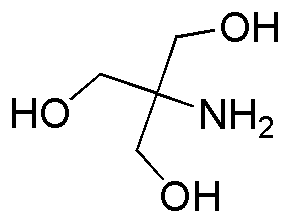2-Amino-2-hydroxymethyl-1,3-propanediol is widely utilized in research focused on:
- Pharmaceutical Formulations: This compound serves as a stabilizing agent in various drug formulations, enhancing the solubility and bioavailability of active ingredients, which is crucial for effective medication delivery.
- Biotechnology Applications: It is commonly used in the production of buffers for biological assays, providing a stable pH environment that is essential for enzyme activity and cell culture processes.
- Cosmetic Products: The compound acts as a moisturizing agent in skincare formulations, helping to improve skin hydration and texture, making it a popular choice in the cosmetic industry.
- Food Industry: It is utilized as a food additive to enhance the stability and shelf-life of various products, ensuring quality and safety in food preservation.
- Laboratory Research: Researchers leverage its properties in various chemical syntheses and analytical methods, facilitating experiments that require precise pH control and stability.
General Information
Properties
Safety and Regulations
Applications
2-Amino-2-hydroxymethyl-1,3-propanediol is widely utilized in research focused on:
- Pharmaceutical Formulations: This compound serves as a stabilizing agent in various drug formulations, enhancing the solubility and bioavailability of active ingredients, which is crucial for effective medication delivery.
- Biotechnology Applications: It is commonly used in the production of buffers for biological assays, providing a stable pH environment that is essential for enzyme activity and cell culture processes.
- Cosmetic Products: The compound acts as a moisturizing agent in skincare formulations, helping to improve skin hydration and texture, making it a popular choice in the cosmetic industry.
- Food Industry: It is utilized as a food additive to enhance the stability and shelf-life of various products, ensuring quality and safety in food preservation.
- Laboratory Research: Researchers leverage its properties in various chemical syntheses and analytical methods, facilitating experiments that require precise pH control and stability.
Documents
Safety Data Sheets (SDS)
The SDS provides comprehensive safety information on handling, storage, and disposal of the product.
Product Specification (PS)
The PS provides a comprehensive breakdown of the product’s properties, including chemical composition, physical state, purity, and storage requirements. It also details acceptable quality ranges and the product's intended applications.
Certificates of Analysis (COA)
Search for Certificates of Analysis (COA) by entering the products Lot Number. Lot and Batch Numbers can be found on a product’s label following the words ‘Lot’ or ‘Batch’.
*Catalog Number
*Lot Number
Certificates Of Origin (COO)
This COO confirms the country where the product was manufactured, and also details the materials and components used in it and whether it is derived from natural, synthetic, or other specific sources. This certificate may be required for customs, trade, and regulatory compliance.
*Catalog Number
*Lot Number
Safety Data Sheets (SDS)
The SDS provides comprehensive safety information on handling, storage, and disposal of the product.
DownloadProduct Specification (PS)
The PS provides a comprehensive breakdown of the product’s properties, including chemical composition, physical state, purity, and storage requirements. It also details acceptable quality ranges and the product's intended applications.
DownloadCertificates of Analysis (COA)
Search for Certificates of Analysis (COA) by entering the products Lot Number. Lot and Batch Numbers can be found on a product’s label following the words ‘Lot’ or ‘Batch’.
*Catalog Number
*Lot Number
Certificates Of Origin (COO)
This COO confirms the country where the product was manufactured, and also details the materials and components used in it and whether it is derived from natural, synthetic, or other specific sources. This certificate may be required for customs, trade, and regulatory compliance.


